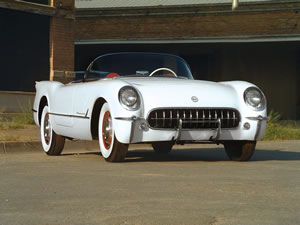1953 Corvette - Number 220 out of 300
Worldwide Auctioneers - The Houston Classic Auction - April 2015:
Lot 21
$275,000 - $325,000
Chassis no. E53F001220
- Fresh, Top-Quality Restoration Performed by Brett Henderson
- One of Only 300 Corvettes Produced for the Inaugural 1953 Model Year Historic First-Year Example of "America's Sports Car"
- An Essential Component of Any Serious Sports Car Collection
235.5 cid "Blue Flame" OHV inline six-cylinder engine, 150 BHP, three single-barrel Carter carburetors, Powerglide two-speed automatic transmission, independent front suspension with unequal-length A-arms and coil springs, live rear axle with semi-elliptic leaf springs, and four-wheel hydraulic drum brakes; wheelbase: 102"
From the start, Chevrolet's Corvette was unique in its concept, design, and execution. Conceived by legendary GM design chief, Harley Earl, as an American alternative to the hordes of nimble and stylish foreign sports cars arriving in postwar America, the new GM design combined striking aircraft-inspired design elements and existing passenger car mechanical components. Clothed in long, low, and sleek bodywork rendered in hand-laid fiberglass, the new show car was known internally as "Project Opel" and designated EX-122 as it quickly took shape.
Eventually named 'Corvette' in honor of the small and fast naval vessels of wartime fame, the new Chevrolet sports car remains significant as one of very few designs of the fertile GM Motorama era to progress to series-production with its show-car styling cues virtually unchanged along the way. Representing a major leap of faith on the part of top GM brass, including GM engineering chief Ed Cole and company president Harlow Curtice, the Corvette was the product of a then-massive $1.5 million investment in the project by the time it was readied for its highly anticipated public introduction.
Dubbed the Corvette "Dream Car," it debuted at the January 1953 GM Motorama show held at the glamorous Waldorf Astoria Hotel in New York City and its impact there was truly astonishing. By the end of that first weekend in New York, over 300,000 had seen the car and some $800,000 worth of GM products were sold at the show. In fact, by the time the Motorama's cross-country tour ended, over four million people reportedly saw the Corvette. Incredibly, production commenced at Flint, Michigan, just five months after its New York debut. All production cars were finished in Polo White paint with rich Sportsman Red interiors. Mechanicals were based upon Chevrolet's existing production car components, including the Powerglide automatic transmission and 235 cubic-inch inline six-cylinder engine, which was hopped up with triple carburetors, a compression boost, and a hotter camshaft.
An eventual switch to steel bodywork was planned, but intense public interest in the show car's unique fiberglass body encouraged GM to continue with the revolutionary new material. Even the Corvette's low-volume assembly process broke from tradition with small groups of technicians. Early Corvettes, numbering some 150, were marketed to the top celebrities via GM's VIP program, ensuring enviable product placement. However, production problems, marketing gaffes, questionable pricing, and sluggish sales nearly caused the Corvette's early demise. However, to be fair, a low-volume specialty car such as the Corvette was a radical departure for any manufacturer, with its body – comprising some 46 fiberglass parts – imposing a particularly steep learning curve. Thankfully, GM and Chevrolet management displayed considerable fortitude and quickly, the Corvette matured into "America's Sports Car."
This wonderful first-year example is the 220th of the 300 Corvettes produced for 1953 and it stands as one of as few as an estimated 225 survivors remaining in existence today. Now offered from a highly knowledgeable consignor, who has owned twelve 1953 Corvettes over the years, this fine example clearly benefits from a freshly completed body-off restoration performed by 1953 Corvette restoration expert Brett Henderson of Pendleton, Indiana's Blue Flame Restoration. As offered, the Corvette stands ready for showing and competition at the highest levels of judged Corvette events and it is complete with full weather gear including a proper convertible top and side curtains, plus a CD documenting its restoration process. With the Corvette progressing through its landmark seventh generation, the very rare first-year examples continue to be highly collectible and desirable touchstones to the Corvette's earliest roots. Accordingly, this particular 1953 Corvette is certainly at the top of its class.
